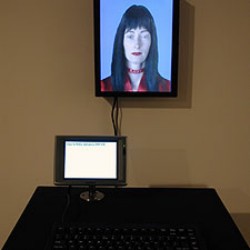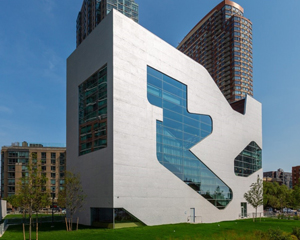Every Little Bit Helps
John Haberin New York City
Analog City and Architecture Now
If you are kind enough to be reading this, I hope that you will think of me as digitally aware. You could not have stumbled across it otherwise.
I started the first Web site devoted to art criticism, of art history and contemporary art, nearly thirty years ago, and it has continued to grow. Before that, though, I had an analog life in a thoroughly analog city, and the Museum of the City of New York will not let me forget it, even if I could. A show all but recaps my life—but is that enough? What of the city's future, analog and digital? What would you do if you could remake New York? Would you think big or think small? 
Would you get started on the largest program of public housing since Robert Moses in the 1950s—or integrate affordable housing throughout the city, on a livable scale? And what of existing nigh-rise apartments? Could architecture take responsibility for working elevators, health, and safety, turning "projects" into neighborhoods? Would you connect communities with a rail line from Brooklyn to Queens, or would you pour that money into subways after years of neglect? Would you give New Yorkers and commuters the Penn Station they deserve, at the cost of office towers all around it? Would you design high-tech schools for a high-tech age, or would you see new charter schools as the problem, not the solution?
Or would you forget that you even asked? How about a few more parks in a gloriously green city, only this time out of reach of mass transit? How about some pocket parks here and there accessible to even fewer? How about a few more pedestals for a few more monuments—monuments almost certain never to be built? Throw in a cultural center amid gentrification, an energy and research center that will not deliver much energy, extended pool hours in Brooklyn, some subway art, and a restored midtown mural, and you have "Architecture Now" at the Museum of Modern Art. Subtitled "New York, New Publics," it seems out of touch with both.
My information economy
I had my first library card by age six, and I grew to rely on the card catalog and the pocket in the front of each book. It held a card, stamped with the due date for each borrower in succession. When it filled up, throw it away! I rode to school with subway tokens in my pocket and returned home to a dial phone without a single smart feature. My mother, in pursuit of a career, paid for an answering service to pick up calls. I taught myself to type on a manual typewriter, which I liked to think had descended from my ex-stepfather's days as a journalist, before he became a news reader on TV. I brought my first electric typewriter to college, even if I needed erasable typewriting paper to make up for my mistakes.
I took lecture notes in longhand, eagerly, although I almost never read them again. Somehow just writing helped me helped me to remember what I saw and heard—a lesson that I have brought to notes on the back of press releases and crossword puzzles in museums today. Without a clear future or a degree, I worked for pittance at a brokerage firm across from a record store (as in vinyl) and New York's City Hall. Think that elections need verification from a recount of hanging chads and paper ballots now? Someone had to verify each day's transactions on Wall Street against paper slips from the trading floor, and so I did. The wood or hot metal of the printing press was ancient history when I graduated and took my first job in publishing, but linotype had come, and print was my life.
A compositor, or typesetter, had to turn an author's manuscript into cold type, but I had to copyedit it first, on paper. The manuscript went out for peer review and proof to the authors, with my reading and commenting on every word. The department got a word processor at my third job, but no one seemed to use it except me. (What a relief from my handwriting!) And still I turned to a Rolodex of contacts, for editing depends on people as much as words. And none of us was in cyberspace.
What has changed, and does it matter? The museum does its homework and puts on quite a show, at the cost of ignoring the present and skimming over the past. Like every exhibition, "Analog City" begins out in the hall, with a quick and dirty summary for visitors with a smartphone and "too much information." This many electric wires, telephones, pneumatic tubes, and miles of subway lines were in place by such and such a date. Public libraries and Wall Street assumed their roles in the personal and public economies of the city. Newspapers survived a blackout and kept printing.
Ready for more, apart from the hard reality of documents, paper copies, and machines? Impressive as they are, entering feels like hitting the "read more" button when you already get the message. You can try old resources for yourself, like hunting down a library book. You get to marvel at those primitive beings who found all this so impressive, as did I. Is life easier or harder now in digital? I might have a less frustrating answer if only New York put more into its resources online.
As so often, the museum is upbeat and informative, but not so good at digging deeper or asking questions. Do computers alter or merely accelerate the information economy? What was lost and what is gained since NYC BC ("before computers")? Can I, frustrated by the limits of analog criticism, still devote myself to in-person views of mostly analog media? So much for computer-generated and computer-assisted art, virtual art fairs and virtual museums, "Thinking Machines" and a "Revolution of the Eye," technology and the Internet. What did it take, analog and digital, to put this very show together, and what sustains New York today? Maybe you can find an answer on the Web.
To remake New York
I began this review with real priorities and real debates. Everyone agrees that New York needs accessible housing, lots of it, but how? Can it deal with displaced low- and middle-income residents and NIMBY among the well off? (If Jane Jacobs is right, the culprit is still Moses, with his refusal of through traffic and his hatred of street life.) The plans for a rail line are the governor's, who often favors upstate New York over the city. She is also behind plans for Penn Station, now abandoned, which seemed likely not to bring in revenue for mass transit, but to drain it for office space that no one needs.
The last major Manhattan development created its own gift to developers and enclave for wealth, Hudson Yards. Its flagship store promptly went bankrupt, and suicides shut off its flagship sculpture by Thomas Heatherwick. Could a new generation of architects bring a new perspective? "Architecture Now" is the latest installment of MoMA's Young Architects Program, after Dream the Combine in 2018, and it lives up to its name. Only one of the dozen firms on display, Adjaye Associates, has much of a public profile, thanks to the National Museum of African American History and Culture, by David Adjaye, in Washington, D.C.
 Yet they seem oddly out of touch. Adjaye has earned praise for a school in the south Bronx, adapted from an ice factory, but the show has only his restored lobby mural for the United Healthcare Workers Union. It is a lesson in mosaics and care, but it is still a blast from the past. (At MoMA, one never even sees it whole.) So is a public pool in Bed Stuy, to which Only If has added a roof, so that it can stay open year round. And one of these projects builds on Morris Lapidus, better known for Miami Beach and his boast of "the world's most pretentious hotel."
Yet they seem oddly out of touch. Adjaye has earned praise for a school in the south Bronx, adapted from an ice factory, but the show has only his restored lobby mural for the United Healthcare Workers Union. It is a lesson in mosaics and care, but it is still a blast from the past. (At MoMA, one never even sees it whole.) So is a public pool in Bed Stuy, to which Only If has added a roof, so that it can stay open year round. And one of these projects builds on Morris Lapidus, better known for Miami Beach and his boast of "the world's most pretentious hotel."
Or maybe they are not out of touch, but taking a stand. Another approach to urban planning actively distrusts architecture, at least the kind that produces towering eyesores near Central Park South and that destroyed Seneca Village to make way for Central Park. This approach prefers the guerilla tactics of "Life Between Buildings" at MoMA PS1. New Affiliates and Samuel Stewart-Halevy call for TestBeds of greenery throughout the city, although all they have to show for it is a board game. Kinfolk Foundation imagines its Monuments Project in three boroughs, too, hardly minding that it can displace the statue of Christopher Columbus in Columbus Circle only in video. It hardly minds either that his Disney-styled replacement, Toussaint Louverture, never set foot in the United States.
Or maybe they are out of touch after all. Peterson Rich sees its plans for the Housing Authority as "scalable solutions," but they add only balconies and a tad more greenery to what already exists. Is that a serious answer to affordable housing or to Moses? Agency-Agency's Tei Carpenter and Chris Woebken would open hydrants to the public, as in those hot summers of my childhood before the fire department locked them down. If New Yorkers lack air conditioning, showers, and drinking water, something is way wrong—and not with fire plugs. SO–IL's Florian Idenburg, Jing Li, and Iwan Baan have a perfectly nice design for a cultural center, as do Eric Bunge and Mimi Hoang of nArchitects for Jones Beach, but the first recycles Brutalism late in the game, of not as well as Alvaro Urbano, and the second looks suspiciously like a parking lot.
I should hate to disparage the raw timbers of another cultural center, by CO Adaptive's Bobby Johnston and Ruth Mandel, or the subway station art of Olalekan Jeyifous in Sunset Park, with its lively riffs on New York street food, although new subway art is everywhere. I should hate, too, to disparage James Corner Field Operations for converting the Freshkills landfill in Staten Island to a park, although I could never get there, and people will still dispose of garbage. I should hate most of all to disparage the park along Hunter's Point in Long Island City, by SWA/Balsley and Weiss/Manfredi. I love the East River walk and Steven Holl's futuristic public library. If anything, they and the curators, Evangelos Kotsioris and Martino Stierli with Paula Vilaplana de Miguel, suffer not from lack of vision, but from an excess of virtue. There has to be more if New Yorkers are to wrest back control of architecture and the city.

"Analog City" ran at the Museum of the City of New York through December 31, 2022, "Architecture Now" at The Museum of Modern Art through July 29, 2023.




